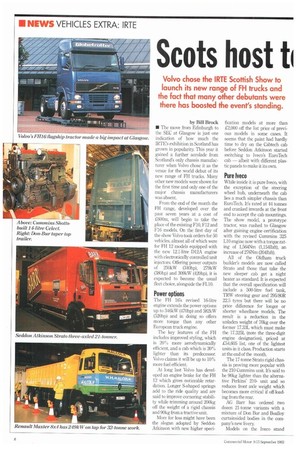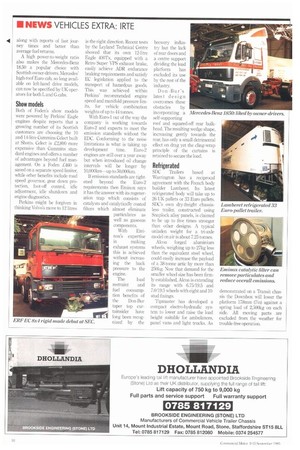Scots host ti ebuts galore
Page 10

Page 11

Page 12

If you've noticed an error in this article please click here to report it so we can fix it.
by Bill Brock • The move from Edinburgh to the SEC at Glasgow is just one indication of how much the IRTE's exhibition in Scotland has grown in popularity. This year it gained a further accolade from Scotland's only chassis manufacturer when Volvo chose it as the venue for the world debut of its new range of FH trucks. Many other new models were shown for the first time and only one of the major chassis manufacturers was absent.
From the end of the month the FH range, developed over the past seven years at a cost of £600m, will begin to take the place of the existing F10, F12 and F16 models. On the first day of the show Volvo took orders for 50 vehicles, almost all of which were for FH 12 models equipped with the new 12.1-litre D12A engine with electronically controlled unit injectors. Offering power outputs of 250kW (340hp), 279kW (380hp) and 309kW (420hp), it is expected to become the usual fleet choice, alongside the FLIO.
Power options
The FH 16's revised 16-litre engine extends the power options up to 346kW (470hp) and 382kW (520hp) and in doing so offers more torque than any other European truck engine.
The key features of the FH includes improved styling, which is 20% more aerodynamically efficient, and a cab which is 30% lighter than its predecessor. Volvo claims it will be up to 10% more fuel efficient.
At long last Volvo has developed an engine brake for the FH 12 which gives noticeable retardation. Longer S-shaped springs add to the ride quality and are said to improve cornering stability while trimming around 200kg off the weight of a rigid chassis and 90kg from a tractive unit.
More for less might have been the slogan adopted by Seddon Atkinson with new higher speci
fication models at more than £2,000 off the list price of previous models in some cases. It seems that the paint had hardly time to dry on the Cabtech cab before Seddon Atkinson started switching to lveco's EuroTech cab — albeit with different plastic panels to make it its own.
Pure Iveco
While inside it is pure Iveco, with the exception of the steering wheel hub, underneath the cab lies a much simpler chassis than EuroTech. It's rated at 44 tonnes and cranked inwards at the front end to accept the cab mountings. The show model, a prototype tractor, was rushed to Glasgow after gaining engine certification with the revised Cummins 325 L10 engine now with a torque rating of 1,564Nm (1,1541bft), an increase of 276Nm (2041bft).
All of the Oldham truck builder's models are now called Strato and those that take the new sleeper cab get a night heater as standard. It is expected that the overall specification will include a 500-litre fuel tank, TRW steering gear and 295/80R 22.5 tyres but there will be no price difference for longer or shorter wheelbase models. The result is a reduction in the unladen weight of 70kg over the former 17.33L which must make the 17.325L (note the three-digit engine designation), priced at £54,605 list, one of the lightest units in it class. Production starts at the end of the month.
The 17-tonne Strato rigid chassis is proving more popular with the 210 Cummins unit. It's said to be 90kg lighter than the alternative Perkins' 210unit and so reduces front axle weight which becomes more critical if off-loading from the rear.
AG Barr has ordered two dozen 21-tonne variants with a mixture of Don Bur and Boalloy curtainsided bodies in the company's new livery.
Models on the Iveco stand included the 100E15, a 10-tonner from the New Cargo range, pow ered by a six-cylinder 5.86-litre engine developing 107kW (143hp) at 2,700rpm and 236Nm (3211bft)at 1,400rpin.
ERF's EC multi-wheeler range, (CM 2-8 Sept), gets its first, outing equipped with the new SMC cab introduced on tractive units in May, providing good wide entry and the modern sweep around instrument binnacle. Six and eight-wheelers are equipped for the toughest working condition with eight-tonne front axles,
The eight-wheeler on show takes the Cummins 325 L10 engine as standard but there is a whole range of power options to choose from. The chassis layout with much of the equipment protected inside but below the top of the main members is best suited to front-end tipping gear but ERF has an alternative layout to take account of underfloor tipping gear.
MAN took the opportunity to introduce a 38-tonne GTIN 6x2 tag-axled chassis for drawbar operation with air suspension on all three axles. ECAS chassis height control, available on MAN models from 7.5 tonnes to 38 tonnes, operates the air suspension on each of the rigid's three axles via a hand-held remote control.
Independent raising and lowering front and rear, achieved without an excessive number of air tanks, is aimed at swap body operations which is an area of continued growth. MAN believes it would grow even quicker if there was some harmonisation between the different demount system designs.
The show model's German 25.375 designation will be changed by a 23 prefix for the UK where the single-wheeled tagaxle limits operation to 23 tonnes for solo operation—easy work for the six-cylinder 12-litre Eco engine rated at 276kW (370hp).
MAN's new 7.5-tonner is expected to appear before the end of the year.
Premium spec
Leyland Daf has a new premiumspec 17-tonner in the 65 Series to replace the 1900 model, powered by the Daf 6.2-litre engine rated at 158kVirr (212hp) and producing 378Nm (5311bft) of torque. Using the same cab as the 75 and 85 Series tractive units, it will be offered alongside the Leylandbuilt but more basic 60 Series in the UK, but which offers a choice of the 210 or 180hp engines.
The 65 rigid chassis specification includes four-point cab suspension, low entry height, sixspeed synchromesh gearbox, a 7.5-tonne front axle, 11.5-tonne drive axle and wheelbases to suit nine body lengths.
The eight-wheeler market in Scotland, up by 7% this year, is showing some signs of recovery.
Renault's fortunes have shown an even more marked improvement since it introduced the Maxter eight-legger, up from 1% to 21%. The G340ti.32D rated at 249kW (338hp) clearly has the level of power preferred by the Scottish haulier and a body payload allowance of 21.71 tonnes must also have its attraction O. Leyland Daf 65-Series 17-tonner replaces the old Daf 1900.
along with reports of fast journey times and better than average fuel returns.
A high power-to-weight ratio also makes the Mercedes-Benz 18.50 a popular choice with Scottish owner-drivers. Mercedes' high-roof Euro cab, so long available on left-hand drive models, can now be specified by UK operators for both I. and G cabs.
Show models Both of 1:Wen's show models were powered by Perkins' Eagle engines despite reports that a growing number of its Scottish customers are choosing the 10 and 14-litre Cummins Celect built at Shotts. Celect is 12,800 more expensive than Cummins standard engines and offers a number of advantages beyond fuel management. On a Foden .C460 is saved on a separate speed limiter, while other benefits include road speed governor, gear down protection. foot-off control, idle adjustment, idle shutdown and engine diagnostics.
Perkins might be forgiven in thinking Volvo's move to 12 litres
is the right direction. Recent tests by the Leyland Technical Centre showed that its own 12-litre Eagle 400Tx, equipped with a Retro Super VPS exhaust brake, easily achieve ADR endurance braking requirements and satisfy EC legislation applied to the n-ansport of hazardous goods. This was achieved within Perkins' recommended engine speed and manifold pressure limits, for vehicle combination weights of up to 44 tonnes.
With Euro-1 out of the way the company is working towards Euro-2 and expects to meet the emission standards without the EDC. Conforming to the noise limitations is what is taking up development time. Euro-2 engines are still over a year away but when introduced oil change intervals will be longer by 10,000km—up to 50,000km.
If emission standards are tightened beyond the Euro-2 requirements then Eminox says it has the answer with its regeneration trap which consists of catalysts and catalytically coated filters which almost eliminate particulates as well as gaseous components.
With Eminox's expertise
in making exhaust systems this is achieved without increasing the back pressure to the engine.
The load restraint and fuel consumption benefits of the Don-Bur taper top curtainsider have long been recognized by the brewery industry but the lack of rear doors and a centre support dividing the load platform has excluded its use by the rest of the industry.
Don-Bur's latest design overcomes these obstacles by incorporating a self-supporting roof and squared-off rear bulkhead. The resulting wedge shape, increasing gently towards the rear; has only a small detrimental effect on drag yet the cling-wrap principle of the curtains is retained to secure the load.
Refrigerated
SDC Trailers based at Warrington has a reciprocal agreement with the French body builder Lamberet. Its latest refrigerated body will take up to 26 UK pallets or 33 Euro pallets. SDC's own dry-freight chassisless trailer, constructed using Snaplock alloy panels, is claimed to be up to five times stronger than other designs. A typical unladen weight for a tri-axle model on air is about 725 tonnes.
Alcoa forged aluminium wheels, weighing up to 27kg less than the equivalent steel wheel, could easily increase the payload of a 38-tonne at-tic by more than 250kg. Now that demand for the smaller wheel size has been firmly established, Alcoa is extending its range with 615/19.5 and 7.0119.5 wheels with eight and 10stud fixings.
Tipmaster has developed a compact electro-hydraulic system to lower and raise the load height suitable for ambulances, panel vans and light trucks. As demonstrated on a Transit chassis the Downbox will lower the platform 178mm (7in) against a spring load of 2,500kg on each side. All moving parts are excluded from the weather for trouble-free operation.


























































































